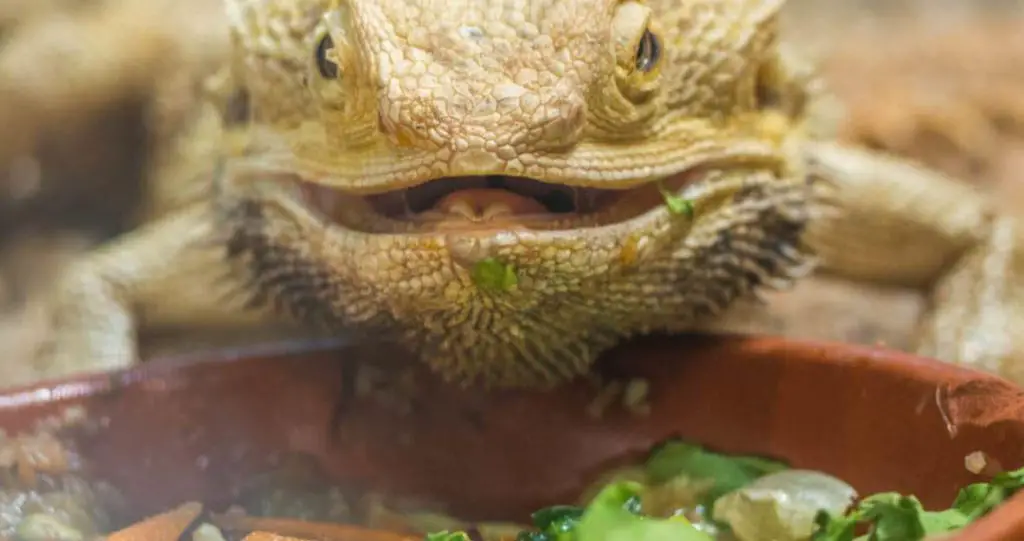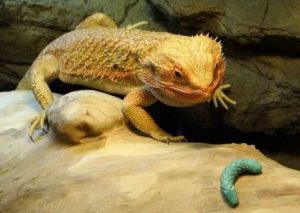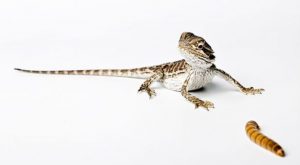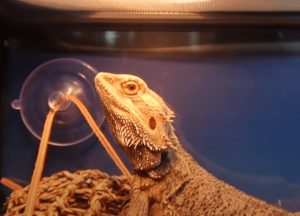What is the best live food for bearded dragons?
Bearded dragons are omnivores as they eat both plants and animals.
In general, a young bearded dragon eats 80% bugs and 20% plants while the diet of adult bearded dragons consists of 80% plants and 20% bugs and insects.
Besides, sometimes, people will find it difficult to feed their young dragons on any vegetables.
This page will give you some knowledge about how to feed your bearded dragon properly and the best live food for bearded dragons.
Related Posts:
- Cool Bearded Dragon Names
- Can Beardies Eat Pears?
- Can Two Beardies Live Together?
- Temperature and Humidity for Beardies
- How to Pick Up a Beardie?
- 20+ Tips to Setup Beardie Tank
- 30+ Beardie Body Language
- How Long Can a Beardie Go Without Water?
What Do Bearded Dragons Eat?
A different variety of vegetation would be the most optimal option for your beardies as they can maximize opportunities for nutrients and limit the risk of antinutrients.
Below is the safe food list diet collected with data from researchers and veterinarians.
1. Vegetables, Fruits, and Flowers
Even though bearded dragons love insects, vegetables, fruits, and flowers should also be part of their diet as those are sources of essential vitamins and minerals.
You can find the complete list of fruits and vegetables that bearded dragons can eat here.
Do Not Feed!
There are many unhealthy or even toxic insects and plants that can be fatal, so knowing them clearly will allow you to avoid feeding your bearded dragon.
- Avocado
- Chinaberry
- Castor beans
- Juniper berries
- Sweet peas
- Potatoes
- Tomatoes
- Citrus fruits
2. Insects
The nutritional quality of the insects is essential. Therefore, gut-loading insects is an efficient way to target special nutrients for your bearded dragon, not for the insects.
Mortality can be caused in some invertebrates within days by nutrients such as calcium.
This is the key reason why you should only perform gut-loading within a day before feeding the insects to your reptile.
You can find the complete list of nutritious insects for bearded dragons here.
Do Not Feed!
Some insects that can glow in the dark such as fireflies, lightning bugs, or any worms contain highly toxic chemical substances, so you should never feed them.
- Fireflies
- Elder bugs
- Insects you found outside
- Venomous insects, such as bees, wasps and scorpions
- Insects sold as bait for fishing
- Any insects that glow
- Insects found inside your home
3. Commercial Food
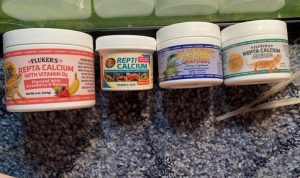
Pet owners can prepare some commercial food by themselves to improve as well as limit the risks of imbalanced diets.
The food lists have been collected from veterinary and researcher suggestions.
Specifically, the following sources: Girling, 2013; Divers and Mader, 2005; Finke, 2012. Brown, 2012; Johnson, 2006; Stahl, 1999; UCDavis, 2019; Mitchell and Tully, 2008; Stahl; Boyer, 2015; and NC State Veterinary Hospital.
Every individual bearded dragon has distinctive needs, desires, and digestive abilities, so make sure you know exactly the particular species you’re keeping before feeding your pet anything.
We recommend these commercial food:
- Fluker’s Repta Calcium
- Zoo Med Reptile Calcium Without Vitamin D3, 8-Ounce
- Rep-Cal Calcium-Phosphorus and Vitamin D3 (Free 4.1 oz Green Bottle)
- Zilla Calcium Supplement Reptile Food Spray
- Fluker’s Reptile Calcium Supplement Without Vitamin D3
What Is the Best Live Food for Bearded Dragons?
1. What Is the Best Live Food for Baby Bearded Dragons?
Maybe it is quite clear now, but I’ll emphasize again that the percentage of protein is the main difference between a young and old beardie’s diet.
a. Feeders
As you may know, a baby beardie requires a richer diet of protein.
Therefore, regarding beardie between 0-2 months, just feed them as many crickets as possible in a 5-10 minute time frame 4-5 times per day.
For 3 to 4-month-old beardie, feed them as many crickets as they want 3-4 times a day in a 5-10 minute time frame.
b. Greens and Veggies
Greens and veggies are still suggested in the diet for baby beardie but not nearly as much as older beardies.
A diet including 80% feeders and 20% veggies is suitable for your baby.
Also, remember to take out whatever food is not eaten within around 30 minutes.
Related Posts:
- Can Beardies Eat Pears
- Can Beardies Eat Squash?
- Do Beardies Eat Rosemary?
- Can Beardies Eat Dill?
- Do Beardies Eat Brussel Sprouts?
- Can Beardies Eat Peas?
- Can Beardies Eat Chard?
c. Calcium and Vitamins
This period is fundamental for your baby bearded dragon, so you should dust their feeders with a calcium/D3 supplement once a day for 5 days a week, but NEVER twice a day.
2 days a week, you shouldn’t provide this supplement. Just douse their feeders with their multivitamins.
2. What Is the Best Live Food for Juvenile Bearded Dragons?
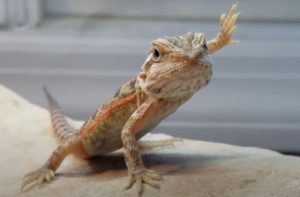
A high volume of protein plays an important role for young bearded dragons to develop appropriately and be big and strong.
By contrast, if an older beardie consumes too much protein, it will simply become overweight and even suffer from health problems.
Related Posts:
- Why Is My Beardie Closing Eyes When Stroked?
- Why Is My Beardie’s Mouth Open? Reasons &Tips
- Signs of Mbd In Beardies
- Why Is My Beardie Breathing Heavy?
- Why Is My Beardie Bobbing His Head?
a. Feeders
When your baby is a little older, you should let your juvenile bearded dragon eat as many crickets as possible 2-3 times a day for 5-10 minute intervals until they reach 9 months of age.
From 9 months to 12 months of age, let them eat as many crickets as possible in 5-10 minutes just 2 times per day.
For example, if your beardie is eating 20 feeders twice a day for a total of 40 crickets, try giving them 15 crickets twice a day instead of veggies.
By contrast, if you want to slowly reduce the number of crickets for a couple of months, you can raise their veggie intake.
Please note: I recommend you still provide your beardie with his salad daily, regardless of the feeder schedule!
b. Greens and Veggies
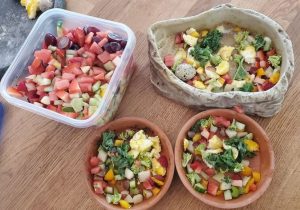
Just be free to apply the 80/20 rule if you like until your beardie is about 9 months old.
At this time, you should start adding more greens to their diet and also give them opportunities to try different food types as well.
Variety is key!
When it is at the age of 12 months, a diet of roughly 50-50 between feeders and greens is ideal for them.
As they grow up at 18 months, the green intake will account for around 80%, whereas the feeder intake will lower to about 20%.
c. Calcium and Vitamins
When they reach 12 months of age, you should maintain the rate at which your beardie receives the same amount of calcium/D3 and a multivitamin.
From this point on, reduce the calcium/D3 to just 3 times a week (no more than once per day) and the multivitamin to one time per week.
3. What Is the Best Live Food for Adult Bearded Dragons?
Adult bearded dragons don’t need to absorb the protein as younger dragons do. Therefore, an adequate beardie diet includes 80% greens and only 20% protein.
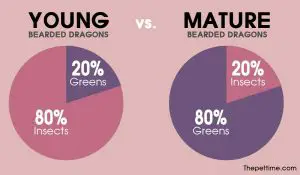
a. Feeders
The number of feeders required will in part depend on their size.
Some adult bearded dragons in large size can consume twice as many crickets a week as smaller adult beardies, without becoming overweight.
- 10 crickets per day or 20 crickets every other day
- 3-5 large Dubias (2”) or 5-9 nymph Dubia (1”)
- 7-10 superworms every other day
- 5-20 phoenix worms per day (in addition to another feeder)
- Regarding the Phoenix worms, I’ve only recommended 5-20 per day because those are expensive feeders.
b. Greens and Veggies
Adult beardie will develop well on a diet consisting of 80% greens and veggies
c. Calcium and Vitamins
Regarding your adult bearded dragon, you can use a dose of calcium/D3 just 2-3 times per week and a multivitamin once per week.
Conclusion
The beardie’s temperament, long life span, and general hardiness would bring interesting things to any family.
If you want to get your first bearded dragon or take another one to your family, these nutrition instructions on the best live food for bearded dragons will help ensure that they stay healthy for many years to come.
If you want to learn more about the best live food for bearded dragons, feel free to contact us!
Key points for selecting the best live food for bearded dragons:
Bearded dragons are omnivorous reptiles that thrive on a diet of live insects and occasional plant matter. Providing a variety of live foods is essential to meet their nutritional needs. Here’s a guide to help you choose the best live food for your bearded dragon:
Key Considerations for Choosing Live Food:
- Nutritional Value:
- The live food should be nutritionally balanced to meet the protein, fat, and calcium requirements of your bearded dragon. Variety is key to achieving this balance.
- Appropriate Size:
- Select live food of an appropriate size for your dragon’s age and size. Avoid insects that are too large, as they may pose a choking hazard.
- Gut Loading:
- Gut-loaded insects are those that have been fed a nutritious diet before being offered to your dragon. This ensures they are a valuable source of nutrients.
- Diversity:
- A varied diet is essential. Feeding a mix of different insects helps provide a broader range of nutrients and prevents dietary deficiencies.
- Breeding Insects:
- Some reptile keepers prefer to breed their own feeder insects, which allows for full control over their diet and nutritional value.
- Convenience:
- Consider the availability of the live food in your area and whether it’s easy to source. Convenience can impact your dragon’s diet variety.
Top Live Foods for Bearded Dragons:
- Crickets: Crickets are a staple in a bearded dragon’s diet due to their high protein content and suitability for all ages. They are readily available and can be gut-loaded.
- Dubia Roaches: These roaches are low in fat, making them a healthy choice for bearded dragons. They are also easy to breed at home.
- Phoenix Worms (Black Soldier Fly Larvae): High in calcium and low in fat, these larvae are an excellent option, especially for young bearded dragons.
- Silkworms: Silkworms are soft-bodied and rich in nutrients, making them a great choice for all life stages. They are, however, more expensive than some other options.
- Mealworms (in Moderation): While mealworms are suitable for occasional feeding, they should not be a staple due to their higher fat content. Use them as a treat or part of a varied diet.
Supplementation:
- To ensure your bearded dragon receives all necessary nutrients, dust the live food with a reptile calcium supplement and a multivitamin as recommended by your veterinarian.
Caution:
- Avoid feeding wild-caught insects, as they may carry parasites or have been exposed to pesticides. Stick to reputable breeders or suppliers.
Feeding Frequency:
- Young bearded dragons require daily feedings, while adults can be fed every other day. Adjust portion size to match your dragon’s age and size.
Providing a diverse and nutritionally balanced diet of live food is essential for the health and well-being of your bearded dragon. Consult with a reptile veterinarian to develop a feeding plan tailored to your specific dragon’s needs and to ensure they receive the proper nutrition to thrive.
Further Reading:
- Carolina Custom Cages Terrarium Review
- 8 Best Basking Rocks for Beardie: What Is the Best Choice?
- 10 Best Thermometers for Beardie: How to Choose the Best One?
- 5 Best Beardie Lighting Setups for Beardie Lovers
- 9 Best Heat Lamps for Beardie: Natural Habitat Provided

